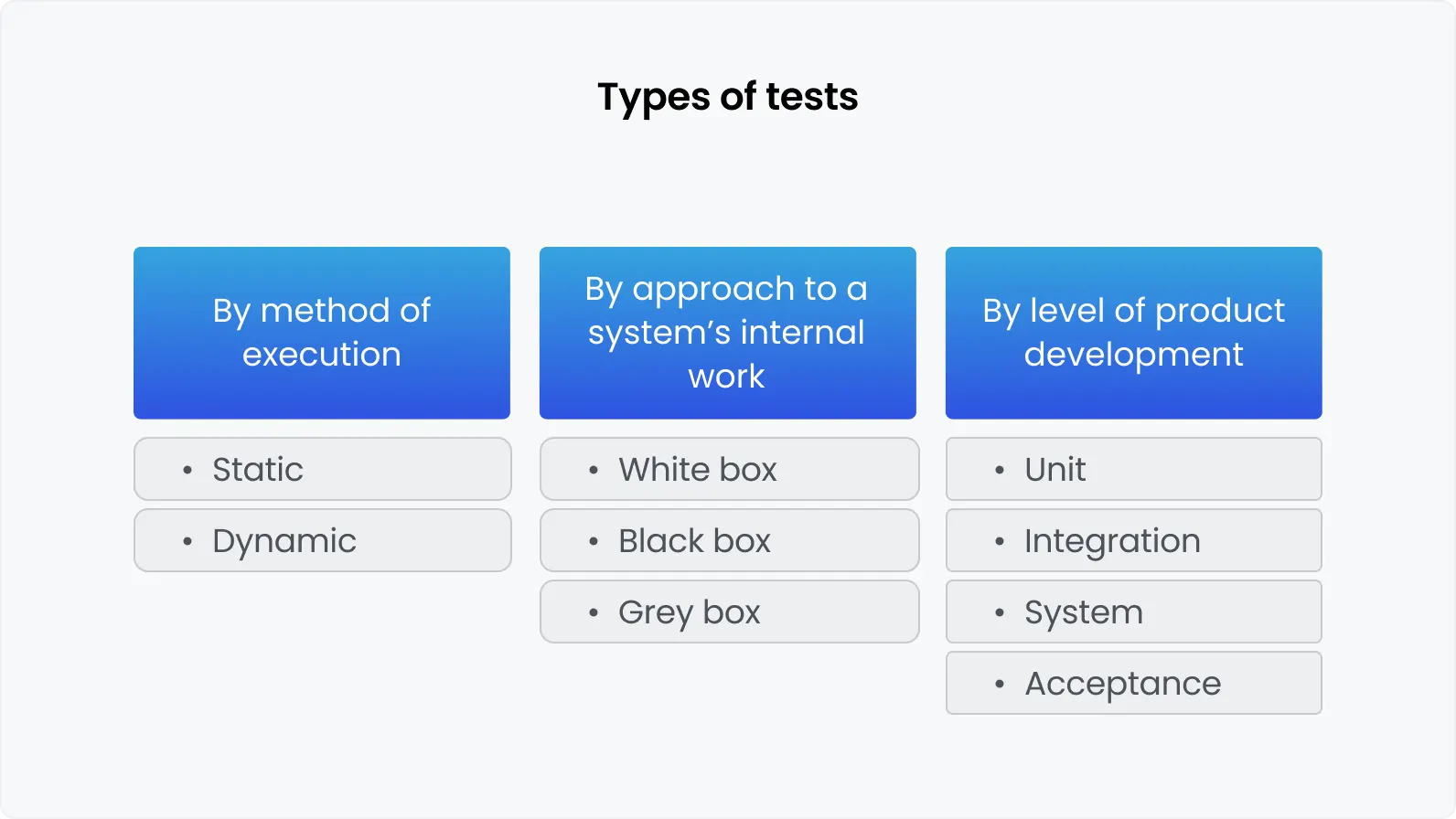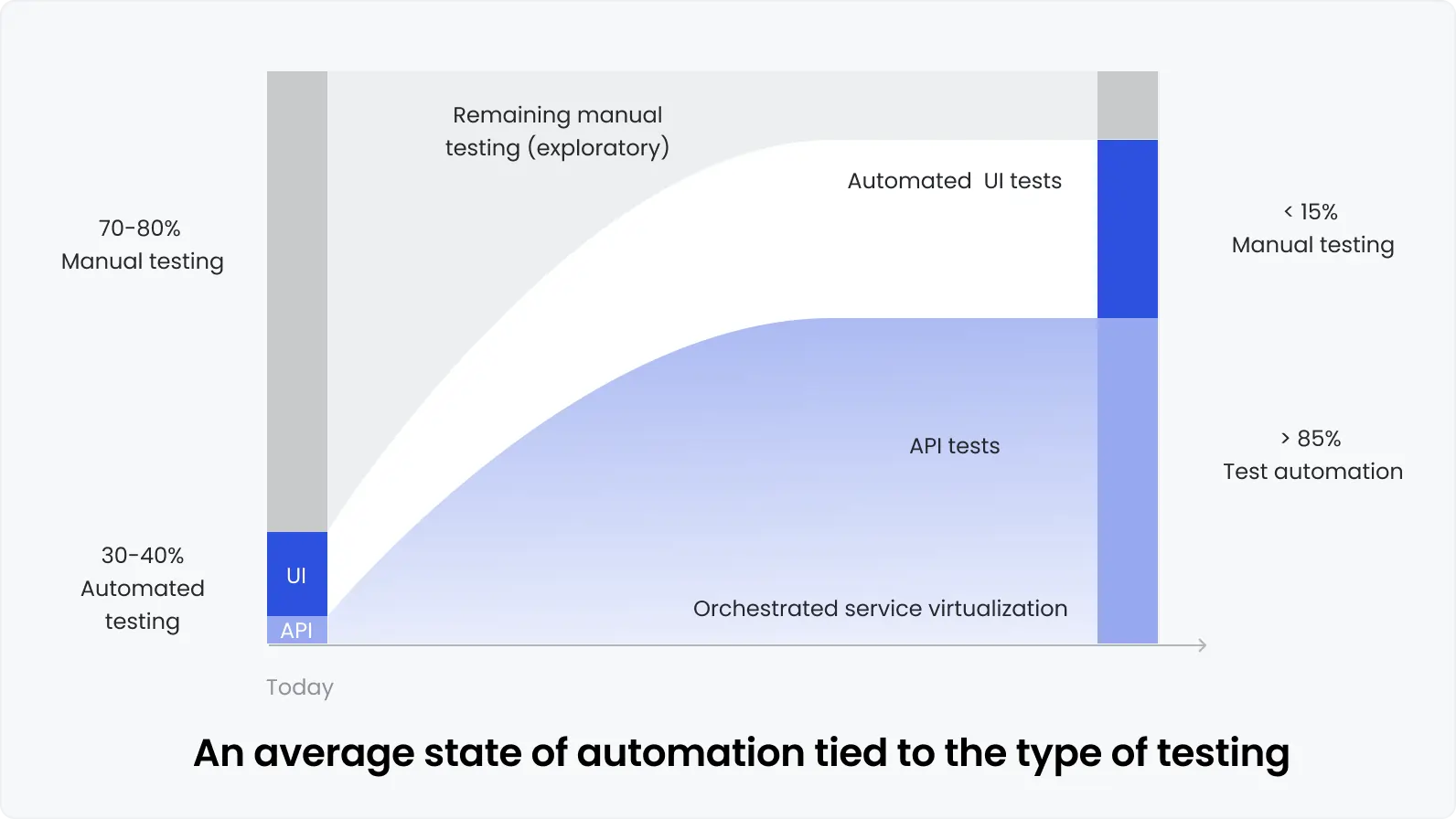14 minutes to read
QAOps vs. traditional QA: A comparative analysis


Mykhailo Ralduhin
Senior QA Engineer
Let’s recall the early 2000s for a while. The famous Mars Climate Orbiter mission failed due to a devastating error — an unmatching between metric and imperial units in its software code. This incident is not only about the importance of communication. Software testing efficiency also takes place here.
At that time, QA was a separate phase, often performed after the development was complete, leaving little room for flexibility or any fast iteration.
Today, software development has evolved, and with it, modern QA practices. Traditional QA involves a linear, phase-based approach where testing occurs after the development process. It’s methodical but may lead to delays.
On the other hand, QAOps sets quality assurance in the continuous development and deployment cycles of DevOps. This way, testing happens simultaneously with development, enabling faster feedback and quicker resolutions.
In this blog article, we’ll provide a clear comparative analysis of QA methodologies. At DeviQA, we are 100% sure that QAOps can address the challenges that traditional QA faces and we will show this to you.
Overview of traditional QA
Traditional Quality Assurance is a process of software testing to ensure it meets the desired quality standards. This process mostly relies on manual testing, where testers follow predefined test cases to assess various aspects of the software (e.g. functionality, performance, security, and usability).

Testing typically comes into play at the end of the development cycle, often after the entire product has been built. The key objective is to identify and fix any defects before the software reaches the end users. Every product has specific requirements and peculiarities of the context it’s used in. So, traditional testing ensures software will run accordingly.
Process and workflow peculiarities
The traditional Quality Assurance process is linear and is based on a waterfall-like structure. The typical flow includes 4-5 stages:
Requirement analysis
Test plan and test case design
Execution
Reporting
Levels of testing phase
Unit testing: Focuses on individual components or functions of the software.
Integration testing: Ensures that different modules or services work together as intended.
System testing: Evaluates the software as a whole in an environment that simulates real-world usage.
User acceptance testing (UAT): Involves real users testing the software to validate that it meets their needs and expectations.
Eventually, the reporting process can have multiple testing iterations and take 2 to 6 months. However, this handoff between development and QA teams can be siloed and (not) a bit inefficient. Tricentis states that at least 63% of development teams and testers operate solely, which commonly results in communication breakdowns and delays in the development process.
Strengths and limitations
| Strengths | Limitations |
|---|---|
| Thoroughness: Traditional QA excels in thoroughness, as testers meticulously follow detailed test cases that cover a wide range of scenarios. This ensures that the software is tested against all known requirements, minimizing the risk of undiscovered defects. | Slower feedback loops: One of the most significant drawbacks of traditional QA is its position at the end of the development cycle. Since testing happens after the code is fully developed, any bugs found require a return to the development phase, leading to slower feedback and extended timelines. |
| Predictability: The structured, phase-based approach allows for detailed planning and predictable timelines. Teams can allocate resources efficiently, knowing exactly when each phase will occur and how long it should take. | Higher costs: Traditional QA can have substantial cost implications. Manual testing is labor-intensive and time-consuming, and bugs discovered late often result in expensive rework. |
| Controlled environment: Testing is usually conducted in a controlled environment that closely mimics the production environment. This helps identify issues that might only surface under specific conditions, leading to more reliable outcomes. | Silos between teams: The handoff model, where development and QA teams work separately, creates gaps. This separation often leads to a lack of shared understanding and miscommunication. That’s why the mentioned Tricentis study points out the rise of automation testing. |
| Documentation: Traditional QA strongly emphasizes documentation. Every test case, defect, and result is documented in detail, providing valuable records that can be used for compliance audits, future reference, or even as training materials for new testers. | Limited flexibility: Traditional QA practices are rigid and don’t easily accommodate changes late in the development cycle. If requirements change or new features need to be added, the entire process may need to be revisited, causing significant delays. |
| Regulatory compliance: In industries with strict regulatory requirements, such as healthcare or finance, traditional QA’s structured approach is often preferred. The thorough documentation and methodical testing process help ensure compliance with industry standards and regulations. | Delayed bug detection: Since testing is deferred until the end of the development cycle, bugs that could have been detected and fixed earlier in the process are often discovered late. This not only delays the project but also increases the risk of critical issues slipping through to production. |
Traditional QA has its strengths, definitely. Particularly in structured and regulated environments. Yet, its limitations (speed, flexibility, and collaboration) are gaining ground as roadblocks.
Overview of QAOps
QAOps is an advanced approach. At least, it was invented relatively recently. Shoring for Quality Assurance Operations, it integrates quality assurance directly into the DevOps pipeline. Comparing QAOps vs. traditional QA, the former embeds quality practices throughout the entire development process: testing is not just a final checkpoint but a continuous, integrated activity that happens in real-time as code is developed, committed, and deployed.
QAOps aims to ensure that software quality is maintained and enhanced continuously without slowing down the development cycle.
Usual QA is like a gatekeeper at the end of a road to any important government institution, only allowing cars (products) to pass through after extensive checks.
QAOps is the same road transition, but quality checkpoints are scattered along the way, ensuring that every step taken aligns with the required standards.
Fast releases with confidence. Powered by QAOps
Process and workflow peculiarities
The QAOps workflow is designed to be iterative and seamless, integrating with the continuous integration and continuous deployment (CI/CD) pipelines.
Automation at the core: Every time code is committed to the repository, automated tests come into play. They can range from unit tests to more complex integration and performance tests. The goal is to catch issues as early as possible, ideally within minutes of the code being written. Usually, all the process runs with Jenkins or CircleCI which orchestrate the CI/CD pipelines.
Continuous integration (CI): In QAOps, CI is about integrating quality. As developers merge their code into the shared repository, automated tests validate the changes in real-time. If a test fails, the integration process is halted, and the developer is immediately notified.
Real-time feedback: When tests fail, developers are alerted instantly, often through integrated messaging apps like Slack or Microsoft Teams. This immediate notification allows developers to address issues before they compound.
Collaboration and visibility: Traditional QA implies a separate work of QA and dev teams. QAOps provides a shared responsibility for quality. For this reason, there are tools like TestRail or Zephyr — to manage test cases and provide visibility into test results and defects across the entire team.
Continuous deployment (CD): Once the code passes all automated tests, it moves seamlessly into the deployment phase. Here, additional checks, such as canary releases or blue-green deployments, may be used to ensure that the software performs well in a live environment.
Strengths and limitations
| Strengths | Limitations |
|---|---|
| Faster feedback loops: By integrating testing into every stage of the development process, QAOps provide near-instantaneous feedback on code quality. This rapid feedback loop not only accelerates development but also reduces the time spent on debugging and rework, allowing teams to maintain a high velocity without sacrificing quality. | Need for specialized skills: QAOps demands a blend of QA and DevOps expertise, which may not be readily available in all teams. QA engineers need to be proficient in automation, scripting, and CI/CD tools, while developers must be comfortable with quality practices and testing methodologies. Bridging this skills gap often requires extensive training and mentorship. |
| Better alignment with development: In QAOps, QA is not an afterthought — it’s an integral part of the development process. This alignment ensures that quality considerations are embedded into every line of code, from the initial commit to the final deployment. Developers and testers work in tandem, with shared tools and goals, leading to a more cohesive and efficient workflow. | Initial setup complexity: Implementing QAOps requires significant upfront investment in tools, infrastructure, and training. Setting up CI/CD pipelines, configuring automation frameworks, and integrating real-time feedback mechanisms can be complex and time-consuming, especially for teams unfamiliar with these technologies. |
| Automation and efficiency: Automation is a core tenet of QAOps. Routine tests, which would be time-consuming and prone to error if done manually, are automated, freeing up QA engineers to focus on more complex testing scenarios. This not only improves efficiency but also ensures that tests are run consistently and reliably every time code is integrated. | Over-reliance on automation: Automation is not infallible. Over-reliance on automated tests can lead to blind spots where certain edge cases or user scenarios are not adequately tested. Also, when an app updates very frequently, it’s difficult to cover these updates with automated test cases. |
| “Bettering”: QAOps fosters a culture of continuous improvement, where feedback from automated tests and real-time monitoring is used to refine and optimize both the code and the testing process. This iterative approach ensures that software quality is always evolving, adapting to new challenges and requirements as they arise. | A cultural shift is a must: Current teams may be afraid of changes as they pose the need of upskilling. They may consider any test advancements additional duty rather than a growth opportunity. Involve the company’s leadership and commit to a culture of collaboration and shared responsibility to overcome the resistance to change. |
| Clear visibility: QAOps significantly boosts collaboration and project ownership. For this reason, tech teams often use Jira, Asana, or another project management tool to track issues, test results, and deployment statuses. | Maintenance routine: Automation reduces the need for manual testing, yet introduces new challenges in maintaining test scripts. CI/CD pipelines and infrastructure are also must be up to date. Sooner or later, the company will grow and the app/software will evolve, so should test scripts. They need to be updated or rewritten to accommodate changes. |
Comparative analysis: Traditional QA vs. QAOps
| Criteria | Traditional QA | QAOps |
|---|---|---|
| Integration with development | Separated approach: QA is a separate phase. Typically, testers come into play after development. Delayed feedback: With the testing at the endpoint, addressing issues can be delayed. | Seamless approach: QA is embedded throughout the development cycle: each phase contains appropriate tests. Real-time feedback: Devs receive conclusions on their code much faster, so they can address them immediately, keeping the process fluid and reducing bottlenecks. |
| Speed and efficiency | Typical time loop: Within days or even weeks, especially in large projects. | Typical time loop: Within minutes to hours. |
| Collaboration and communication | Less collaborative: The separation can create a lack of cohesion between teams. | Highly collaborative: Regular interactions and shared responsibility. |
| Resource allocation | Higher costs: Time and human efforts are the most expensive things in the world. Yet, they are not supposed to be effective…always. Average spending: Traditional QA can cost up to 25-30% of the total project budget. | Lower long-term costs: Automation and early defect detection reduce the need for extensive rework. Average spending: QAOps can reduce testing costs by up to 20-30% over time due to efficiencies gained through automation and continuous testing. |
| Adaptability to change | Stiff structure: Developers often can implement changes to code only after the entire scope of tests. There is nothing groundbreaking about delays in such a case. Limited flexibility: The segmented approach makes it hard to pivot quickly with new requirements. | Flexible and adaptive: Continuous integration and testing allow for easier incorporation of changes. High adaptability: QAOps supports rapid adjustments; it’s much easier to respond to project changes and market demands. |
Best practices for transitioning to QAOps
Assessment and planning

Size up your current process on bottlenecks: You may encounter delays in testing, working over missed bugs, or inefficiencies in communication between teams. Only a clear understanding of your specific pain points allows you to prioritize areas for QAOps integration.
Map a plan: You can’t get from America to Europe without an understanding that there is actually “an ocean between us”. That’s why a clear-cut plan is so important, otherwise you risk going under. Clear means with specific details on how and when you will implement key QAOps practices and how they align with your overall development strategy.
Set measurable goals: Every endeavor, whether it’s conducting a comparative analysis of QA methodologies or digital transformation, must be based on clear and measurable goals. Want to reduce time to market? Define the measure. Wonder if it’s possible to increase test coverage? Set an adequate coverage “volume”. Improving defect detection rates? Strictly define a desired rate.
Tool selection and integration
Appropriate tools: Start off evaluating your current tech stack and identifying gaps. Look for tools that can seamlessly integrate with your existing systems and enhance your current workflows. Use observing blogs or consult with a seasoned pro.
Prioritize integration: Consider Jenkins (for CI/CD), Selenium (for test automation), and Docker (for environment consistency). Chances are these tools can integrate with your current infrastructure, minimizing disruptions during the transition and ensuring a smoother process.
Pilot before full-scale implementation: Let’s test it — this should be your motto if you want to hit the tech jackpot. Pilot projects with selected tools in a controlled environment allow safe space to figure out if your approach works. Set your eyes on workflow compatibility, refine configurations, and address any issues before a full rollout.
Training and upskilling
Let your people grow: Moving to QAOps requires new skills across the team. Start with foundational training on automation tools (Selenium, TestComplete, Katalon Studio, etc.), CI/CD pipelines, and infrastructure management. Check training providers on the level of practice knowledge and make sure to conduct hands-on sessions.
Encourage obtaining certification: Certifications in relevant areas like DevOps, cloud infrastructure, or specific QA tools are another “influential move” that strikes two birds with one stone. On the one hand, it boosts the team’s skills. On the other hand, it builds your confidence in handling new QAOps processes.
Learning culture is key: Don’t limit yourself to certifications. Continuous learning through workshops, expert-led sessions, and peer-to-peer training is also very helpful. Moreover, such opportunities can attract top talents. As an additional perk, but still. Regularly assess skill levels and identify further training needs to ensure business continuity.
Monitoring and optimization
Monitor in real-time: Once you leverage all the benefits of QAOps, start monitoring the performance of your processes: Grafana and Prometheus monitor key metrics (test coverage, defect detection rates, and deployment frequency) in real-time.
Regular review and adjustment: The trick is to review established metrics with your team to identify areas for improvement. This might involve adjusting test cases, refining automation scripts, or recalibrating CI/CD pipelines based on performance data.
Ongoing optimization: Optimization is another trick. QAOps practices are an adjustable thing as well. Fine-tune processes, incorporate feedback, and adapt to new challenges to maintain a QAOps efficient process.
To sum up
Modern development doesn’t pose questions like “QA automation vs. manual testing”. Manual testing is also important (remember the statistics of automation adoption at the beginning of the article). However, QAOps integrates quality assurance directly into the development process. That is each stage of the development cycle contains particular tests. Such integration leads to more efficient workflows, unlocking these QAOps advantages:
Accelerate time-to-market through automation and continuous testing.
Improve software quality by preventing defects early in the development cycle.
Enhance collaboration and communication among development, QA, and operations teams.
Reduce costs through automation and improved efficiency.
Increase adaptability to changing requirements and technologies.
DeviQA offers expert QAOps services tailored to your organization's specific needs. Contact us to learn more about how we can help you achieve your goals effortlessly.
Team up with an award-winning software QA and testing company
Trusted by 300+ clients worldwide



